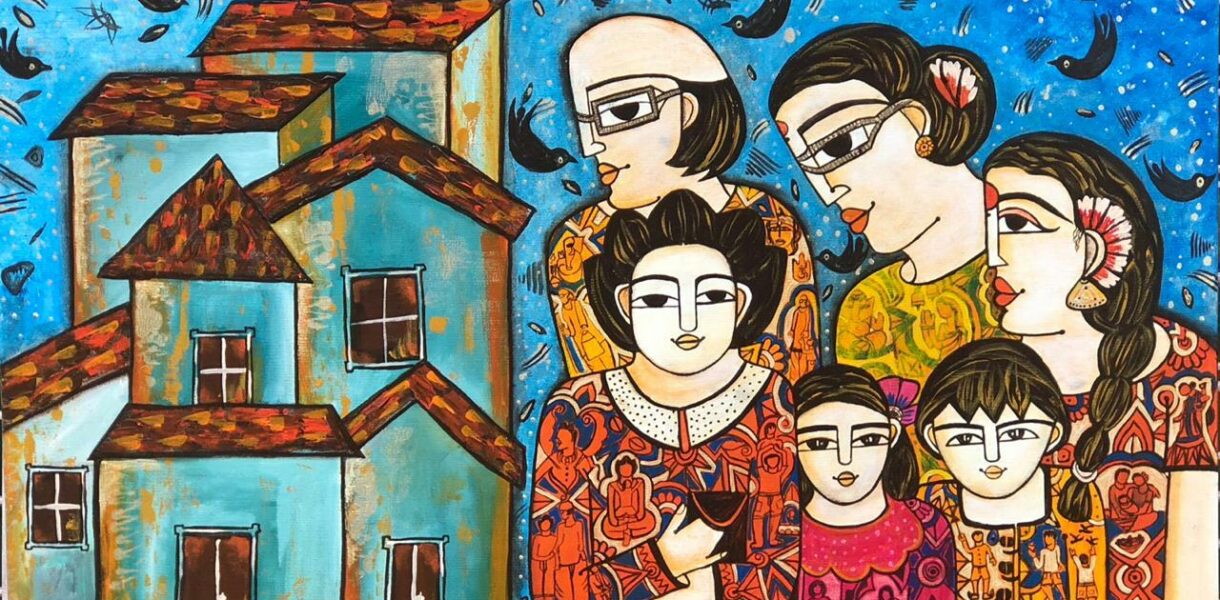
The joint family in India, as hinted by classic Hindu mythology epics such as Mahabharata and Ramayana, is said to have been in existence as early as 1,000 B.C. and as proposed by the definitions of Irawati Karve (1953)[1] is a structure characterized by cohabitation of genealogically related individuals guided by the authority of senior members of the family in matters such as marriage, employment, worship, property, etc. Individual members of the family jointly own property invest capital and reap profit and the role of an individual is dictated by roles and norms associated with their gender. Contrary to popular belief, the joint family structure persists to a large extent in today’s world as per a BBC article titled ‘Why Indians continue to live in joint families’[2] published as recently as September 2020. Backed by research carried out by Etienne Breton[3] (2019), a demographer and visiting fellow at Cornell University who published his findings in late 2019, the article states that while India may have seen a rise in nuclear families, the rise is modest at best and not as significant we may have thought. The continued existence of the joint family, a social institution that has historically been known systematically oppress women is problematic in the present day context of empowered women across the world attempting to gain an equal footing in the world and challenge gender stereotypes along with their pursuits to have the freedom of choice in regards to employment and spouses among others. Analysed under the lenses of the 21st century definition, individuality, marriage and concerning parallels between the joint family and the modern industry, the troubling aforementioned survival of the joint family system is evaluated in this essay to determine its impact on the progress of the women of India.
In the lifetime of its existence any institution undergoes some form of change as a result of the evolution of the social context in which it finds itself and the same applies to the joint family. It is necessary to consider the modern-day definition of the joint family and the features that characterizes it as these have direct implications for the women who may find themselves in this structure. Research shows the 29% increase in urban joint families in India is attributed to economic reasons such as rising cost of housing along with taking care of the elderly and help to take care of the children given that more women have jobs outside their homes.[4] These findings indicate that women and families in general are revaluating their perceptions of the joint family to convert the institution that previously suppressed them to one that can facilitate their modern role as working women. However, defining what constitutes a joint family has been challenging for even early sociologists. Early sociologists like Karve[5] stress that cohabitation is a necessary factor to be considered a joint family while I. P. Desai[6] (1956) did not give as much importance to size and residence as he gave to apparent relationships that bind households together. These interpretations are condensed by Bina Gupta in her work Modernity and the Hindu Joint Family[7] to conclude that a joint family is one ‘held together by a discrete and stable network of social obligations’ which in the Indian context could mean multiple forms of relationships thereby enlarging the scope of what qualifies as a joint family. Additionally, in the life course of an individual or a couple, they find themselves in different household types at different stages of life which is a phenomenon termed ‘the developmental cycle of the domestic group’[8] as a result of which the joint family structure may not be a constant in a woman’s life. Given the fluidity of both the meaning and the amount of time a woman may spend in a joint family acts as an advantage in modern times as it demonstrates the adaptability of the joint family structure so that women may have autonomy and pursue professional goals while staying tethered to but not entirely controlled by tradition and family bonds.
When the aspect of individuality in a joint family is considered, individuality and decision-making power is limited to the male head of the family who exercises primary control over all crucial decisions. In Indian society social hierarchies are prevalent as seen in caste, gender and class hierarchies among others, as a result of which the ideas of gender equality, individualism, equal opportunity are not widely accepted[9] and structural hierarchies like those of the joint family persist. In this structure the men themselves have no power to take independent decisions without approval from the family head thus it can easily be imagined what the position of a woman who is essentially a stranger being married into a gender biased family, would be like. Keeping in mind the patrilineal and patrilocal structure, Ursula Sharma[10] (1980) observes that despite women’s employed status they are subordinate to men and have limited power to make decisions therefore suggesting that achieving employment does not guarantee direct autonomy in the family structure. This revelation indicates that an employed woman cannot be assumed to be a woman who has equal say at home and there are underlying issues regarding a woman’s agency in the joint family that lie in the family dynamics and until these internal hierarchies and gender biased allotment of roles is addressed changes to the family structure cannot be expected. Keera Allendorf’s research in Women’s Agency and the Quality of Family Relationships in India[11] (2012) establishes that a woman’s agency, that is, a woman’s ability to make choices is directly influenced by the quality of relationships with husbands, mothers-in-law and other family members. She concludes that higher quality relationships create an environment where a woman can assert herself better and her choices and opinions are taken into account by senior members of the family.[12] Thus, in today’s day and age individuality of a woman still remains threatened by the joint family structure and access to employment and education may provide empowerment in other social institutions but in the context of the joint family, unless there is a fundamental change in the dynamics that may be achieved through an improvement in the relationship quality, a woman cannot achieve autonomy in the family. To add, the prospect of improved relationships in present times seems more attainable given the increased importance placed on family relationships today. However, it must also be noted that in the operation of the joint family the family as a whole rather that its individual members is considered as a unit and decisions are taken for the benefit of this unit as a whole thus a certain degree of individuality for any member not just limited to women, will always be lost.
Marriage in the joint family is seen as a religious sacrament and a social duty which aims to bind not only two individuals, but two families[13]. Traditionally, the two individuals are bound in matrimony by an arrangement decided by the heads of the family with little contribution or power to protest the decision from the individual who is to be bound[14] . In modern times with the increase in age at which people get married, widespread education, greater participation of women in the work force, increased acceptance of divorce and widow remarriage along with the transnational distribution of liberal ideas there has been a change in attitude favouring these practices[15]. However, the analysis of researchers including T. Thomas[16](1995) have acknowledged a shift following Indian independence in 1947 in the fundamental nature of marriage in India. Thomas notes that while the parents still hold the responsibility of shortlisting suitable candidates for their children, the children do have greater liberty to express their choice of spouse from the given pool of worthy candidates. This new model retains an important and influential role of the parents while providing greater if not complete autonomy for the individual to express their opinion in a crucial decision that shapes the rest of their lives. The change, as Thomas expresses himself is due to the incompatibility of the older form of arranged marriage with modern times however this new form taken by the institution of marriage cannot simply be assumed to be a shift from joint to conjugal families but rather a new sociological model which A. A. Khatri terms as the ‘Adaptive Extended Family’[17] that manages to retain traditional values while adapting to modernity. In 1963, W. J. Goode’s[18] observation on the modernization of the family stated that India is undergoing an ideological change (ideas of liberty and progression) faster than a behavioural change (implementation of those ideas in social institutions) and the traditional Indian family patterns would not simply be transformed by social development but would rather come to embody these changes in society while maintaining their identity and the above mentioned unique form of marriage that has been inculcated in the joint family system is the epitome of this transition. The emergence of this new marriage model is partially reassuring to the modern Indian women as it proves that even though the joint family system is still prevalent today it has adapted to provide women a certain degree of autonomy in choosing their spouse and in era of changing attitudes acknowledges the increase in the age of marriage and change in attitude towards women however it is still not fully accepting of the ideas of inter-caste and love marriages[19] but the previously observed ability to make changes in accordance to modern ideals provides hope for a more liberal future.
When industrialization was ushered in with modern times, it was assumed that the joint family business model will not be able to coexist with this change however Milton Singer[20] in his research drew parallels between the separation of ownership and control and the principles of household management in joint families to those of the modern industry. For instance, a manager of a company who oversees the company’s daily affairs and makes binding decisions in the interests of its stakeholders who, including the manager, have a stake in the company while the joint family has a male head who handles the jointly owned assets of the individual family members including himself in the interests of the family as a whole however his decision is binding and he has maximum control. This parallel is concerning because the joint family fits right into the mould of capitalism and urban industry instead of being mutually exclusive given the contradicting modern and traditional ideals they represent. As theorized by Friedrich Engels[21], capitalism is known to strengthen patriarchy by limiting a multitude of wealth to a few men making women more dependent on them and while men are being exploited as cheap sources of labour and are underpaid they are exploited as free sources of household labour completely dependent on the male members in their homes. Instead of modern ideas of gender equality and equal opportunity for all taking centre stage, the joint family system allows for the persistence of gender biased capitalist structures and if it is joint families that are going to take over and participate in the so called modern industry it is only inevitable that the gender norms and limiting roles that originate from the joint family will penetrate the industrial environment, and strengthen the barrier to the attainability of gender equality that may have resulted from the urban ideas of women empowerment and modern industry existing in the same sphere. These direct interactions of the three aspects, labour (in house gender based division of labour and occupational division of labour in the labour market), cathexis (dynamics within intimate, emotional and personal relationships, including marriage, sexuality and childrearing) and power (operating through social relations such as authority, violence and ideology in institutions)[22] have lasting implications as these interactions form the gender order, i.e. the patterns of power relations between masculinities and femininities in society. In response to this crisis, exists Marxist feminism[23] which notes the faults in a capitalist society as Marx did but adds the dimension of gender inequality as a critique of capitalism which Marx did not consider in his evaluation. In the context of the present day the partnership exercised by the joint family and the modern industry is threatening to the women’s movement towards equal standing in society. A possibility of change and hope for women in this scenario is the Adaptive Extended Family[24] which has led to a modification of the joint family in accordance with urban values and also is in line with the Marxist Feminist goal to achieve a restructuring of the family and hope this transition has positive consequences on the above mentioned issue.
In conclusion, this essay finds that the lack of clear boundaries in the modern definition of an Indian joint family is reassuring to Indian women as they are not bound by the rigidity of a fixed structure and the adaptability of the structure with different times in their lives allows the state of their liberties to evolve and women today use the joint family’s adaptive nature to mould it into a structure that facilitates their progress by making the balance of family and employment more attainable. Additionally, individuality that is threatened in a joint family can be solved primarily by higher quality family relationships as a tool to improve family dynamics which could be assisted by the encouraging attitude towards high quality relationships in present times. The findings in the most part favour the women in India today as they depict that while the joint family has lasted the test of time, it has adapted to create a new model that holds on to traditional processes and values while embodying modern ideas, as seen in the greater autonomy provided in the new marriage model and the new rationale applied today for staying in a joint family. Threats do remain as seen in the parallels between the joint family and urban business model but there is still hope for women that this model will evolve over time and be restructured to include women as the Marxist feminism criticism of it gets more attention, similar to how the other institutions within the joint family did.
Photo Source: Joint Family by Nandini Verma
Reference
-
Irawati Karve. 1953. Kinship Organization in India. Poona: Deccan College. ↑
-
Soutik Biswas. 2020 . Why Indians Continue to Live in Joint Families. BBC, September 13, 2020. https://www.bbc.com/news/world-asia-india-54053091. ↑
-
Etienne Breton. Modernization and Household Composition in India, 1983-2009. POPUL DEV REV. 45 (4): 739-766. (2019). https://doi.org/10.1111/padr.12293. ↑
-
Why Joint Families are Back in Urban India, TIMES OF INDIA, July 16, 2017. https://timesofindia.indiatimes.com/home/sunday-times/why-joint-families-are-back-in-urban-india/articleshow/59614752.cms. ↑
-
Irawati Karve. 1953. Kinship Organization in India. Poona: Deccan College. ↑
-
I. P. Desai, The Joint Family in India – An Analysis. Sociol. Bull. 5 (2): 144-156. (1956). ↑
-
Bina Gupta. Modernity and the Hindu Joint System: A Problematic Interaction, International Journal on World Peace. 11 (4): 37-60 (1994). https://www.jstor.org/stable/20751999 ↑
-
Patricia Uberoi, The Family in India, Beyond the Nuclear versus Joint Debate in WRITING THE WOMEN’S MOVEMENT. (Mala Khullar, 2005) ↑
-
Bina Gupta. Modernity and the Hindu Joint System: A Problematic Interaction, International Journal on World Peace. 11 (4): 37-60 (1994). https://www.jstor.org/stable/20751999 ↑
-
URSULA SHARMA, WOMEN, WORK AND POVERTY IN NORTH-WEST INDIA (1980). ↑
-
Keera Allendorf. Women’s Agency and the Quality of Family Relationships in India. POPUL. RES. POLICY REV. 31 (2) (2012). https://www.jstor.org/stable/41409614. ↑
-
Id., 118. ↑
-
T. M. Thomas, Modernity and the Hindu Joint Family System, International Journal on World Peace 12 (1): 3-9 (1995). http://www.jstor.com/stable/20752015. ↑
-
A. A. Khatri, The Adaptive Extended Family in India Today. J. MARRIAGE FAM. 37 (3) (1975). https://www.jstor.org/stable/350528. ↑
-
WILLIAM J. GOODE, WORLD REVOLUTION AND FAMILY PATTERNS. (1963). ↑
-
Thomas, supra note 13. ↑
-
A. A. Khatri, The Adaptive Extended Family in India Today. J. MARRIAGE FAM. 37 (3) (1975). https://www.jstor.org/stable/350528. ↑
-
WILLIAM J. GOODE, WORLD REVOLUTION AND FAMILY PATTERNS. (1963). ↑
-
Avijit Pathak. 2020, A Society That Fears Love, THE TRIBUNE, December 1, 2020. https://www.tribuneindia.com/news/comment/a-society-that-fears-love-178193. ↑
-
Milton Singer, The Indian Joint Family in Modem Industry in STRUCTURE AND CHANGE IN INDIAN SOCIETY 423- 440. (Milton Singer & Bernard S. Cohn 1968). ↑
-
Anthony Giddens, Sociology 616- 617 (2009). ↑
-
R. W. Connell, Gender and Power (1987). ↑
-
Anthony Giddens, Sociology 616-617 (2009). ↑
-
Khatri, A. A. The Adaptive Extended Family in India Today. J. MARRIAGE FAM. 37 (3) (1975). https://www.jstor.org/stable/350528. ↑





I’m not sure exactly why but this website is loading very slow for me.
Is anyone else having this problem or is it a problem on my end?
I’ll check back later and see if the problem still exists.
At this time I am going away to do my breakfast, afterward
having my breakfast coming over again to read other news.
It’s very simple to find out any matter on net as compared
to textbooks, as I found this paragraph at this site.